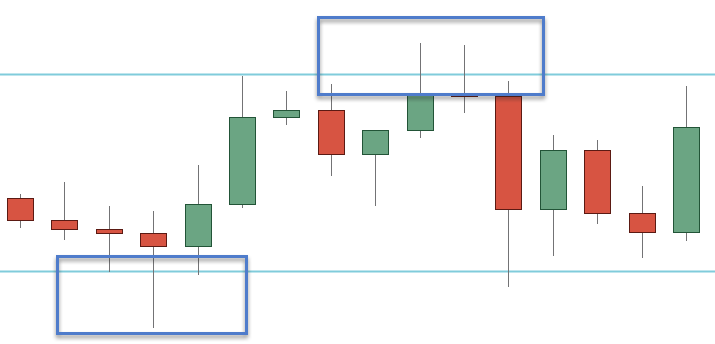Channel trading is simply trading price action within the confines of a trading channel. Trading channels, in theory, encompass the current volatility in price action and anything outside the norm of current volatility may be considered an extreme move.
In this swing trading strategy, we are not looking to trade price extremes but are trading the reactions at support and resistance areas of the channel.
The horizontal channel trading strategy trades the area of congestion between an upper resistance level and lower support level.
This chart has come off an uptrend and the left side of the chart is where a retracement (pullbacks) has terminated. Price rallies and we start to see the formation of a horizontal channel that may provide trading opportunities.
- This is the original point of the resistance portion of the trading channel. You can see on the whole chart that price is making a horizontal move and that is why we call this trading a horizontal channel. There are also up and down sloping channels we can trade.
- Price has pulled back into the zone at the left side of the chart. If price holds (which it does), we can confirm support and take a trade. Depending on the size of the horizontal channel, you may decide to look for price action on lower time frames for a swing trading price entry.
- Resistance holds and we look for a move back down to the support zone
- We see price drop but not come fully into the support zone. This is a bullish sign especially when supported with price action as we see with the reversal candlestick. If you don’t want to trade every bounce, look for this type of price action to support a trading decision for a possible breakout
- Price explodes with momentum to the upside break the resistance area of the horizontal channel
How The Horizontal Channel Forms
You may be wondering why a horizontal trading pattern shows up. The truth is that we are seeing the natural evolution of price.
Many people will look at as stages:
- Accumulation stage where positions are taken in the market
- The markup stage when profits are made and late comers jump into the market propelling price
- The distribution stage where profits begin to be taken
- The markdown stage where unwinding of positions happen.
This evolution of price happens in all markets in all time frames. Remember this when you think you are seeing a stage 3 but the market continues going up.
A market trends and once the balance of buyers/sellers evens out, forward motion begins to cease. In these stages, profits are taken and positions are taken. We use price action to see what is really happening: Price Leaves Clues.
Channel Trading – How To Trade Horizontal Channel Patterns
Once we’ve put in a top (1) and confirmed the presence of support (2) we can begin to look for reversal candlestick patterns to get a trade entry.
You can look for engulfing patterns, pin bars, inside bars…..there are several ways to enter the trades.
For profit targets, the rule of thumb is to trade the opposing side of the horizontal price channel. That simple means
- Trade from support to resistance
- Trade from resistance to support
Your stop placement is extremely important. When trading horizontal patterns, a break above or below DOES NOT MEAN we have a successful breakout we can trade.
You will read on many trading websites to “place your stops just beyond support or resistance”. DO NOT DO THAT.
Markets seek order flow and sitting beyond channel extremes are stop…both protective stop orders and buy/sell stops to enter positions. We also have sideline traders looking to trade a breakout.
The areas on the chart are very common and are simply tests of zones. If your stop is sitting there, you will be exiting your trade at the precise time you should be entering.
You can use stops such as an ATR stop or even structure stops below the horizontal channel extremes.
Why Trade Horizontal Channels
These are simple price patterns with clearly defined areas of not only entry areas, but also failure areas. You also have your profit target areas on the chart..which is price structure.
Horizontal channels are fairly easy to see on a chart, especially higher time frames, which make them great swing trading price patterns. Having a defined area on the chart to pay attention to can keep you out of the “looking for a trade” mentality.
You can also pinpoint these zones and then drop to a lower time frame from a strong price action reversal pattern. This will give you a better trade entry and possibly a bigger position size.
One other great thing about channel trading especially in line with the dominant trend is you can be in the big moves long before other traders.
Other traders, fearful of missing the move, will jump into the trade further propelling your trade into profit.
Drawbacks of Trading Channels
I don’t see much of a drawback for any trader who accepts the risks of trading. Yes, you could be taking a short at resistance and then an upside breakout occurs. That’s trading.
With proper position sizing and a keen eye on risk, there is not a drawback that you should be concerned with.
Please like and share this post if you found it useful!






 Posted in
Posted in